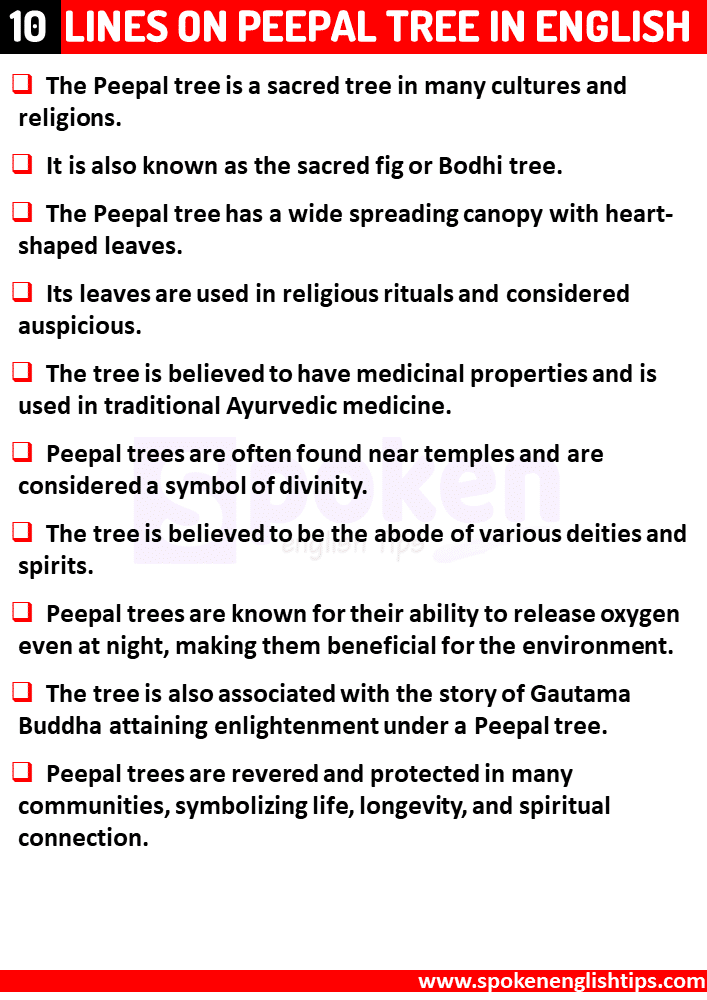Sharing with you 10 lines on Peepal Tree in English, 10 Lines on My Peepal Tree in English for Classes 1, 2, 3, 4, 5, 6, 7, 8. These 10 Lines, short and long essays are very helpful for all students and children. Also, I have shared key points to remember for primary students.

10 Lines On Peepal Tree In English
- The Peepal tree is a sacred tree in many cultures and religions.
- It is also known as the sacred fig or Bodhi tree.
- The Peepal tree has a wide-spreading canopy with heart-shaped leaves.
- Its leaves are used in religious rituals and are considered auspicious.
- The tree is believed to have medicinal properties and is used in traditional Ayurvedic medicine.
- Peepal trees are often found near temples and are considered a symbol of divinity.
- The tree is believed to be the abode of various deities and spirits.
- Peepal trees are known for their ability to release oxygen even at night, making them beneficial for the environment.
- The tree is also associated with the story of Gautama Buddha attaining enlightenment under a Peepal tree.
- Peepal trees are revered and protected in many communities, symbolizing life, longevity, and spiritual connection.
Essay on Peepal Tree in English
The Peepal tree, scientifically known as Ficus religiosa, holds immense significance in various cultures and religions. It is a deciduous tree that belongs to the fig family. With its majestic appearance and cultural importance, the Peepal tree has captured the hearts and minds of people for centuries.
The Peepal tree is often referred to as the sacred fig or Bodhi tree. Its distinct features include a wide spreading canopy and large heart-shaped leaves that rustle gently in the breeze. These leaves hold religious significance and are used in various rituals and ceremonies.
In many traditions, the Peepal tree is considered auspicious and holds a special place near temples and other sacred sites. It is believed to be the abode of gods and spirits, making it a symbol of divinity and spiritual connection. People often offer prayers and make offerings under its shade, seeking blessings and protection.
Apart from its spiritual importance, the Peepal tree also possesses medicinal properties. It has been an integral part of traditional Ayurvedic medicine for centuries. The tree’s leaves, bark, and roots are used to treat various ailments and promote overall well-being.
One remarkable feature of the Peepal tree is its ability to release oxygen even during the night. This unique characteristic sets it apart from most other trees and makes it an important contributor to the environment. The constant release of oxygen helps purify the air, creating a healthier ecosystem around the tree.
The Peepal tree is also associated with an iconic event in history. According to Buddhist tradition, Gautama Buddha attained enlightenment while meditating under a Peepal tree in Bodh Gaya, India. This event further adds to the tree’s reverence and spiritual significance.
In many communities, the Peepal tree is revered and protected. It symbolizes life, longevity, and the interconnection between nature and spirituality. People take great care to nurture and preserve these trees, recognizing their importance in maintaining a harmonious balance between humans and the natural world.
Key Points to Remember for Children and Students in Table
| Key Points for Children and Students |
|---|
| Peepal tree is considered sacred in many cultures. |
| It is also known as the sacred fig or Bodhi tree. |
| The tree has wide spreading canopy and heart-shaped leaves. |
| Peepal leaves are used in religious rituals and are considered auspicious. |
| The tree is believed to have medicinal properties. |
| Peepal trees are often found near temples. |
| They are associated with divinity and considered the abode of deities. |
| Peepal trees release oxygen even at night, benefiting the environment. |
| Gautama Buddha attained enlightenment under a Peepal tree. |
| Peepal trees symbolize life, longevity, and spiritual connection. |
- Essay on 15 August in English
- 10 Lines On Good Habits In English
- 10 Lines On Indian Flag
- 10 Lines On Water Pollution
- 10 Lines On Christmas In English For Class 3